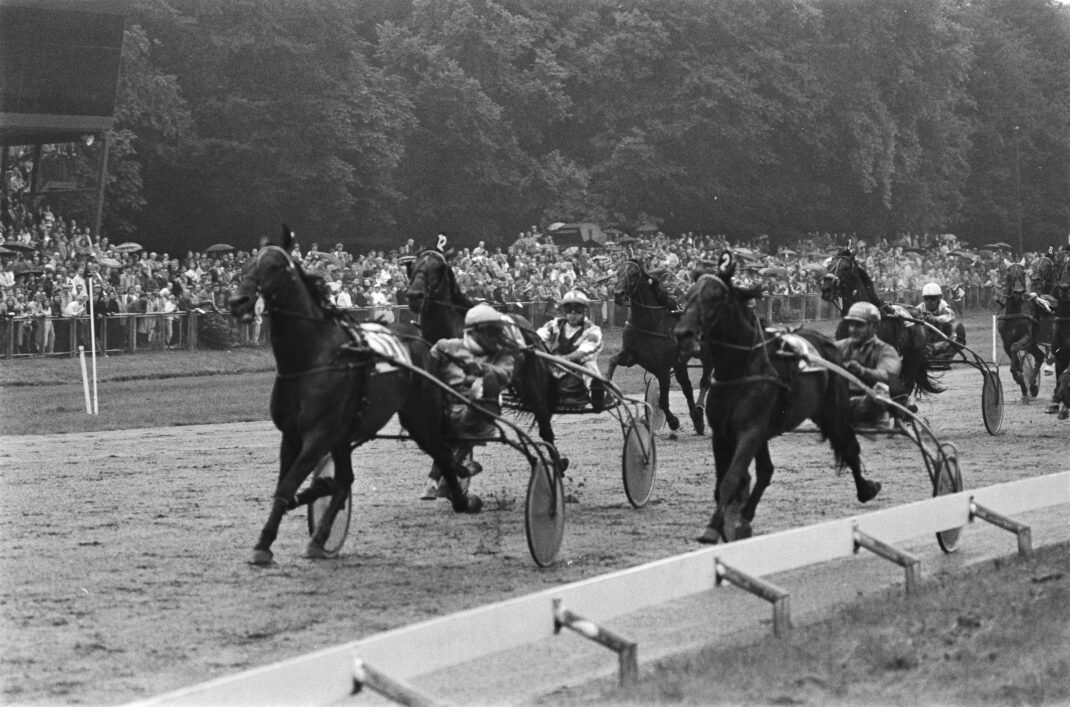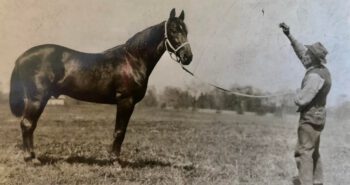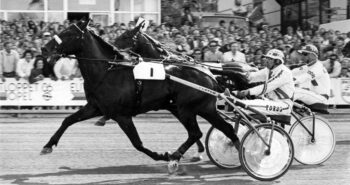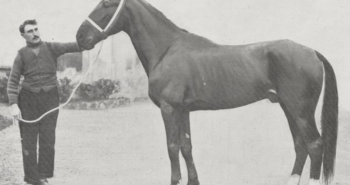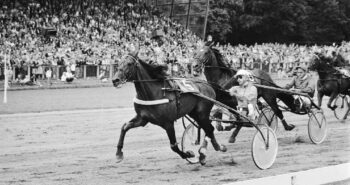He was a nasty colt, and the only – to date – Elitlopp-winner to be led to the winners’ circle by two grooms holding a chain. The blue-blooded trotter Jorky was no treat to be around, and he was a handful for his opponents as well. The only horse to win all four group I-Criteriums in France, Jorky was a mean superstar.
Jorky’s career had started 3 years earlier in rather bizarre fashion. Making his debut on Apr 3, 1978,in the Prix Enif, he was driven by Serge Chavatte, who was not having his best day. After one lap, the driver sent Jorky forward to the lead. In the last turn he ups the tempo and Jorky loses his opponents. When passing the post for the second time, Serge Chavatte stopped his horse, as if the race was over. But … you guessed it – the race wasn’t over. The field caught up to Jorky. The driver, realizing his embarrassing mistake, got Jorky going again but the colt only managed to finish seventh. Still, he had shown class, and from then on he was top of the crop.
At 3 and 4, Jorky was clearly the best in the crop, though he lost a few races to his contemporaries. When it really mattered, though, in the Criteriums, he won in dominant style. His last start at 4, though, came in the Prix Marcel Laurent, which also was open to 5-year-olds. Here Jorky, for the first time, came up against the horse would be his arch-nemesis later: Ideal du Gazeau. The latter won the race in 1.16,9 (2:03.4) ahead of Icarios and Jorky. Further behind were other top trotters such as Ianthis and Istraeki.
Two months later, on Feb 18, 1980, Jorky put in a strong performance to second in the Prix de Selection, finishing second to Kepi Vert despite a 50 meter handicap. The Kerjacques-son trotted in 1.16,0 (2:02.1), his best time so far in his career.
Finally considered ready to take on the best aged trotters – Jorky had sat out the Prix d’Amerique three months prior – in the Prix de l’Atlantique at Enghien on Apr 14, 1980. Up against the great Hadol du Vivier, Jorky was still the best and won in 1.17,3 (2:04.2), shortly before Hadol du Vivier, while the rest were several lengths behind. In the following start, the Grand Prix du Sud-Ouest, he narrowly loses, again, to Ideal du Gazeau, but still firmly establishes himself as one of the very best aged trotters in France – despite only being five years old. In the latter race, Jorky lead almost the whole way. However, the blue-blooded trotter was equally comfortable sitting parked outside or attacking from cover late in the race.
Becoming an international star
Leopold Verroken then took his star abroad for the first time, going to Munich for the Grosser Preis von Bayern. Again it resulted in another narrow loss, this time to Swedish trotter Express Gaxe, but Jorky did well and finished just ahead of Ideal du Gazeau. The latter still proved a tough nut to crack, though, as illustrated by when he won the Prix Rene Balliere in June that year, trotting in 1.15,3 (2:01.1), a new track record, while Jorky was second in 1.15,8 (2:02).
On Jun 29, 1980, Jorky took his first international win when he crossed the line first in the Grote Prijs der Lage Landen, defeating a field of Mustard, Charme Asserdal, Ianthin and Express Gaxe. Two months later, on Aug 30, he became historic when he won the Criterium des 5 ans, again winning several lengths ahead of his opponents. As an added bonus, he also beat the race record which Ideal du Gazeau had set one year prior – and the latter had in turned erased the previous race record belonging to Vanina B, Jorky’s dam. Finally Jorky’s win was also the first time a winner of Criterium des 5 ans was a foal or two former winners; his parents Kerjacques and Vanina B won the race in 1959 and 1970, respectively. Later, Fleuron Perrine won the Criterium 3 and, 4 ans and 5 ans, though he didn’t win the Criterium Continental.
In October, Verroken took Jorky back to Munich for the Preis der Besten. The French trotter was irresistible in the latter half and won by a full second. It was the first of three consecutive wins in the prestigious German race. Then, in November, Jorky won the Gran Premio Delle Nazioni in Italy in equally irresistible fashion.
The unfair loss
When Jorky then won the Prix Marcel Laurent in December, it was his 8th straight win, as well as the 11th win of the year. Expectations were high in front of the Prix de Belqique and Prix d’Amerique, but in both he “only” finished second. In the Prix de Belgique, Ianthin completed his legendary feat of winning all four B-races in the same winter meeting, but Jorky only lost by a head after a very strong finish. His loss in the Prix d’Amerique, on Jan 25, was of the heartbreaking kind. Leopold Verroken’s superstar encountered severe traffic problems and lost around 15 lengths after Club Special and Grandpre went off-stride a little prior to the bottom of the downhill. Far behind Ideal du Gazeau, Jorky launched a ferocious attack three- and four-wide and gained a little on Ideal du Gazeau with every step. At the finish line it’s less than a length separating the two, but the challenge was simply too much, even for the brilliant Jorky. It was still an insane finish, but the earlier traffic problems caused him to lose out on the crowning Prix d’Amerique-win he so truly deserved.
After more traffic problem in the Prix de France the following week, Jorky finally regained his winning way in the Prix de Paris yet another week later, on Feb 8, 1981. In a rather odd coincidence, the following day Jorky’s legendary sire Kerjacques away. Given a rest after a mediocre performance in the Prix de Selection, 1981 would be a very international year for Jorky.
Displaying his temper
A win in Germany earned him an invite to the 1981 Elitlopp, a race where there was going to be another first for Jorky. It was the first time the victor was led to the winners’ circle in chains securely held in place not by one, but by two grooms. The French trotter spent most of the warm-up kicking away at Leopold Verroken, who coolly ignored colt’s antics. However, come race time Jorky was the consummate professional. Although losing narrowly by a nose to Burgomeister and Billy Haughton in the elimination, it was under no urging from Verroken and it obvious that he could have won had the driver asked for a little extra. The second elimination was then won by Ideal du Gazeau. In the final Verroken parked his temperamental colt outside the leader and controlled everything before leading the rest of the field in the final stretch, winning by two lengths in 1.13,1 (1.57.4f). French horses are generally known to be tough and Jorky had made it clear in the warm-up that he was not Mr. Nice Guy – but the sight of an Elitlopp winner in chains in the winners’ circle still surprised some people.
At Solvalla, one of the beaten finalists was Ideal du Gazeau. Him and Jorky clashed soon after in Copenhagen. There Verroken sent the Kerjacque-son to the lead immediately, and the duo held off Ideal du Gazeau in a close finish. After wins in the Grote Prijs der Lage Landen and Elite-Rennen, Jorky was off to American – and Ideal du Gazeau went with him. The arch-enemies put on stunning displays but matters off the track ruined it for Jorky in the 1981 International Trot. Getting boxed in early, his rival Ideal du Gazeau held all the aces despite being parked outside. With one lap to go, Verroken managed to get out of the box. Still, the colt wasn’t himself. When Ideal du Gazeau stormed to the front down the backstretch, Jorky couldn’t stay glued to his back. He finished strong to finish second, but stood no change of defeating his fellow Frenchman.
Jorky wasn’t at his best that day anyway, and Verroken knew even before the race that it was going to be very different to win. The temperamental French colt was not at home at Roosevelt Raceway, where he was in a stall close to other horses. With mares around, Jorky was more of a stallion than a racehorse and attempted to bite a another colt to get to a mare. In the hours leading up to the race, Jorky wasted a lot of energy. The hothead carried his lack of focus to the track, and Verroken had to keep his star away from other horses in the warm-up and post parade.
One week later it was rematch time in the Challenge Cup. Ideal du Gazeau and Jorky turned the race into a French duel in the last lap, and after an intense fight down the final stretch it ended in a dead-heat.
Injuries start to play a role
After wins in the Preis der Besten and next Amiens in France, Jorky then started the 1981/82 winter meeting in excellent fashion by winning the Prix de Bretagne. However, his fans were concerned when the trotter was scratched from the Prix du Bourbonnais. After another scratch, from the Prix de Belgique, it was revealed that Jorky suffered from a circulatory disorder and also a tendon injury in his left front foot. These problems, and also stallion duty, kept Jorky away from the races for several months, but after a good comeback in La Capelle, Verroken took Jorky for another trans-Atlantic journey. Ideal du Gazeau again won the International Trot, but in the Challenge Cup Jorky again triumphed – and this time he didn’t have to share the glory with his nemesis.
After winning the Preis de Besten and again in Amiens, his injury problems returned and Jorky missed out on the 1982/83 winter meeting. He would finally get another crack at the Prix d’Amerique crown in 1984. The nine-year-old trotter was then past his best, yet put in a masterful performance to finish second to Lurabo. One week later he made his swansong in the Prix de France. Clearly not sound, Jorky the fighter refused to go quietly into the night and earned a standing ovation from the crowd after the race in which he finished sixth. The superstar was then permanently retired to stud.
A golden background
That he became a huge star on the track was no surprise given his pedigree. Out of the French champion stallion Kerjacques, his dam Vanina B was one of the top trotters in France in the early 70s. In 1970 she won 11 of 12 races including some of the biggest races for the 1965 crop and she also held the track record at Vincennes. When the 1971 Prix d’Amerique came, she had 10 consecutive wins to her name and had just won the Prix de Bourgogne ahead of Une de Mai. She wound up second behind Tidalium Pelo, who won in a new race record time, but ahead of Une de Mai who finished third. She got her revenge the following week when she beat the same opponents to win the Prix de France and she won several other bigger races before an injury sidelined her for a long time. She returned to the track but not at the same level although two years later, when Dart Hanover won the Prix d’Amerique, Vanina B finished a respectable fifth. Vanina B herself is the daughter of Carioca II out of La Coulonces, a very interesting French mare.
La Coulonces became one of the fastest horses in Europe when she won the Criterium International in 1.15,9 (2:02.1) at Enghien. She also finished second and was a major part of the infamous 1962 edition of Grand Criterium at Cagnes-sur-Mer. La Coulonces is the full brother to Remember, best known as the damsire of Ourasi. She was later shipped to the US where she started in a pacing race at Yonkers (!) on Oct 24, 1962, finishing fourth behind winner Career Boy.
A miracle of nature
Vanina B had a very tough temper that she passed on to Jorky. That she did so has later been described as a miracle of nature. As the undisputed champion stallion, Kerjacques was extremely popular and every year 60 broodmares were selected from around 400 applicants. But not all had to apply. A few exceptional mares got a spot automatically and Vanina B got such a spot in 74, 75 and 76. In 1975 Jorky was born but in subsequent years Vanina B got in foal but miscarried. An analysis showed that Vanina and Kerjacques were not blood compatible and that the mare developed anti-bodies that forced the miscarriage. After that discovery she was never bred to Kerjacques again. Additionally, La Coulonces had both fertility issues and bad luck – twice delivering twins that both died – so she only produced 3 foals in 14 years. Unfortunately Vanina B seemed to have some fertility issues of her own as well and only produced 6 foals.
In 1987, after 13 breeding seasons, Vanina B had only produced 4 foals. Her owner (and breeder) Bernard Billard did something very unusual: he applied to the French association for special permission to use Embryo transfer. The French association granted the application and on Sep 25, a daughter, Allez Coulonces, by Lutin d’Isigny, was born. Born so late in the year she was not raced, but immediately became a broodmare. Not suffering from any fertility issues, she produced 14 foals. One of her foals, the daughter Kiss Me Coulonce, by And Arifant, was initially kept by Billard, but auctioned off in October 2005 while in foal to Jardy. Not generating too much interest, the Dutchman Paul van Klaveren bought her for 11,500 euros. The following spring she gave birth to 1.14 (1:59) trotter Scoop Star and van Klaveren then bred her to his own stallion, Imoko, a stallion that was not considered very fashionable at the time, to produce Timoko.
Jorky died quite young, at the age of 14, from a stomach rupture on 29 March 1989. He stood stud for the first time in 1982 and even though he also had some fertility issues, not producing too many foals, he was also a rather average sire and at the time of his death he was not attracting that many broodmares. Given his fantastic pedigree and even more fantastic career he had been considered one of those few “can’t miss” prospects as a stallion. That he wasn’t has probably tarnished his racing legacy a bit, too. Another reason is his bad luck in the Prix d’Amerique, losing out on two and traffic problems ruining his golden opportunity in 1981. This is a shame, though, because Jorky was one of the best in the world in his time. Of course, the same can not be said for his temper. Be it on or off the track, nobody messed with Jorky.
Jorky
Bay colt born in Coulonces, France on Jun 4, 1975. Died in France on Mar 29, 1989.
Kerjacques – Vanina B (Carioca II)
58 starts: 28-13-3 – 1.13,1 (1:57.3f) – €1,338,326
Breeder: Bernard Billard
Owners: Bernard Billard
Trainer: Leopold Verroken
Drivers: Serge Chavatte, Leopold Verroken
Groom: –

